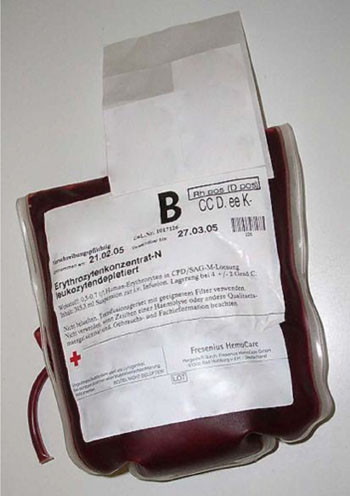Transfusion Protocols Compared After Cardiac Surgery
By LabMedica International staff writers
Posted on 26 Mar 2015
Unnecessary blood transfusions may increase healthcare costs both directly, because blood is an increasingly scarce and expensive resource, and indirectly due to the complications associated with transfusion.Posted on 26 Mar 2015
Cardiac surgery patients who receive blood transfusions are believed to have more complications such as infections, heart attacks and strokes, and this has led to speculation that avoidance of transfusion will improve clinical outcomes.

Image: Plastic bag containing 0.5 to 0.7 liters of packed red blood cells in citrate, phosphate, dextrose, and adenine (CPDA) solution (Photo courtesy of Fresenius HemoCare).
A team of scientists led by those at the University of Bristol (UK) and those at Nuffield Department of Population Health (Oxford, UK) recruited patients over 16 years of age undergoing non-emergency cardiac surgery to the clinical trial at 17 UK hospitals. Participants with a hemoglobin (Hb) level of less than 9 g/dL after their operations were randomized to have a transfusion either when they became substantially anemic (transfuse when Hb is “low,” i.e., less than 7.5 g/dL) or straightaway, when they were mildly anemic (transfuse when Hb is “high,” i.e., less than 9 g/dL).
To compare the two transfusion strategies the medical team counted the number of patients who had a serious infection, stroke, heart attack, gut or kidney failure during the first three months after the operation. The trial analyzed information for 2,003 participants, about four times more than the next largest similar trial of low and high thresholds for transfusion in patients having heart surgery.
The scientists found almost all the patients in the “high” group had a blood transfusion (92%) whereas just over half of the patients in the “low” group had a blood transfusion (53%). Slightly more patients had one or more of the serious complications listed above in the “low” group (35%) than the “high” group (33%). Moreover, more patients died in the “low” group (4.2%) than the “high” group (2.6%). This latter finding is clearly very important but it is difficult to interpret because the trial was not primarily designed to compare the difference in the number of deaths. The restrictive threshold was not superior to the liberal threshold with respect to postoperative morbidity or total costs.
Barnaby C Reeves, DPhil, MSc, MFPHM, a professor and lead author of the study, said, “Although only a hypothesis, the suggestion that it might be better rather than worse to transfuse patients who are only mildly anemic goes against the evidence about when to transfuse in non-cardiac surgery settings. Transfusing more rather than fewer patients would create a challenge for hospitals. With an aging population and possibly an increase in heart disease, obesity and diabetes, it can only become more difficult in the future to maintain the national blood supply in the UK and in other developed countries around the world. Our findings emphasize the importance of interventions to reduce blood loss in the first place.” The study was published on March 12, 2015, in the New England Journal of Medicine (NEJM).
Related Links:
University of Bristol
Nuffield Department of Population Health














